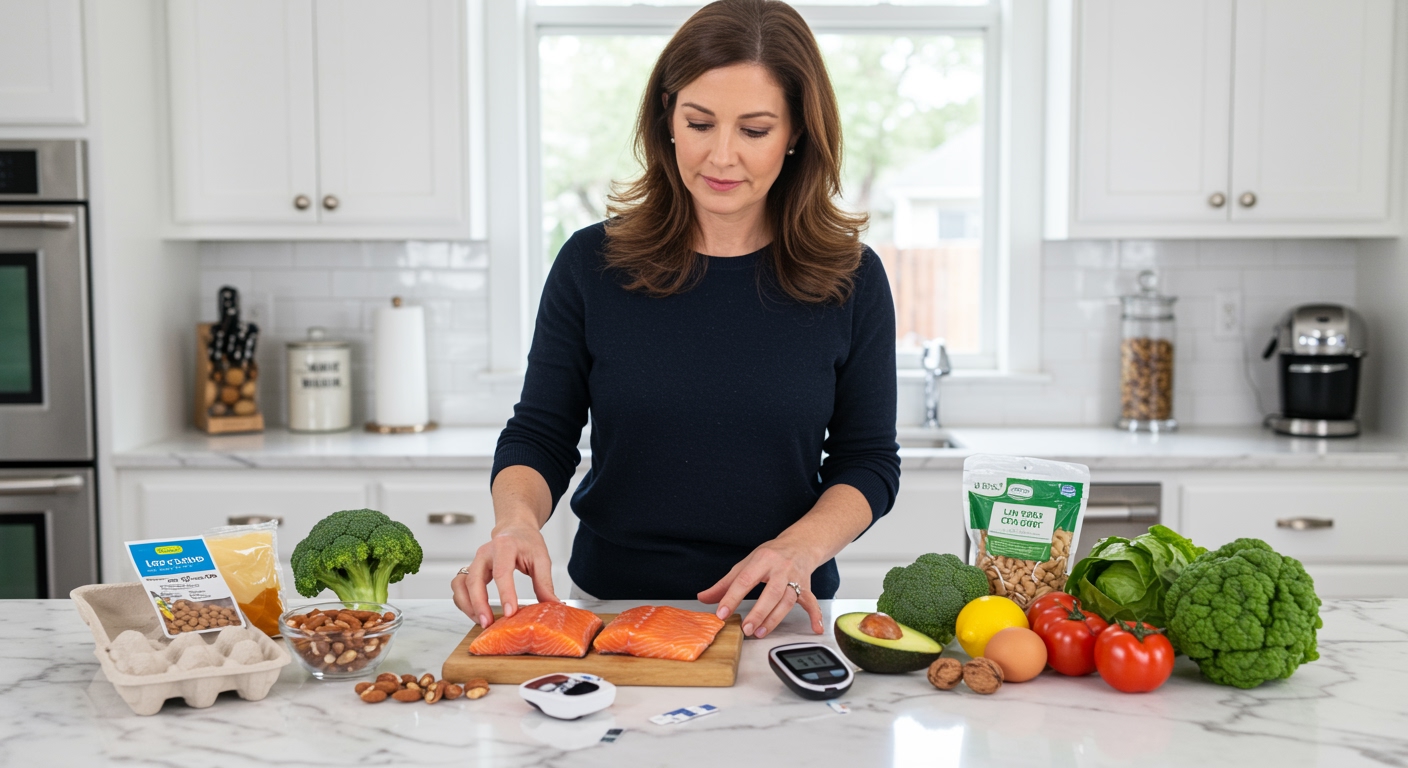✪ Key Takeaway: Atkins diet can improve blood sugar control in diabetics but requires medical supervision for medication adjustments.
Introduction
Your doctor just told you that your blood sugar levels are too high and you need to make changes fast.
You might be wondering if the popular Atkins diet could help manage your diabetes while still letting you enjoy satisfying meals without constant hunger.
Hi, I’m Abdur, your nutrition coach and today I’m going to explain whether the Atkins diet is truly safe and effective for people with diabetes.
How Does Atkins Diet Affect Blood Sugar Levels?
The Atkins diet works by dramatically reducing carbohydrate intake to force your body into a metabolic state called ketosis.
When you eat fewer than 20-50 grams of carbs daily, your body stops relying on glucose for energy and starts burning fat instead.
This process creates molecules called ketones that your brain and muscles can use as an alternative fuel source.
For people with diabetes, this dramatic carb reduction can lead to significant improvements in blood sugar control within just a few days.
Research shows that low-carb diets like Atkins can reduce hemoglobin A1C levels by 0.5 to 1.5 percentage points in people with type 2 diabetes.
Your pancreas produces less insulin when carb intake drops, which helps reduce insulin resistance over time.
✪ Fact: Studies show Atkins can reduce diabetes medication needs by up to 50% in some patients within six months.
What Are The Benefits For Type 2 Diabetics?
Type 2 diabetics often experience rapid weight loss on Atkins, which directly improves insulin sensitivity and blood sugar control.
The high protein and fat content keeps you feeling full longer, reducing the urge to snack on high-carb foods that spike blood sugar.
Many people report stable energy levels throughout the day without the typical blood sugar roller coaster of highs and crashes.
Your triglyceride levels often improve significantly while HDL cholesterol increases, creating a better overall lipid profile.
The diet eliminates processed foods and refined sugars that cause the most dramatic blood sugar spikes in diabetic patients.
Some people with type 2 diabetes can reduce or eliminate their need for blood sugar medications under proper medical supervision.
✪ Pro Tip: Track your blood sugar four times daily during the first month to monitor how your body responds to carb restriction.
Can Type 1 Diabetics Follow Atkins Safely?
Type 1 diabetics face unique challenges with Atkins because they cannot produce any insulin naturally and depend entirely on injected insulin.
The dramatic carb reduction requires careful adjustment of both basal and bolus insulin doses to prevent dangerous blood sugar swings.
Without proper insulin management, type 1 diabetics risk developing diabetic ketoacidosis, a life-threatening condition where ketones build up to toxic levels.
However, some type 1 diabetics successfully follow modified low-carb approaches with intensive medical monitoring and frequent blood sugar testing.
The key is working closely with an endocrinologist who understands how to adjust insulin-to-carb ratios for very low carbohydrate intake.
Many type 1 diabetics report better blood sugar stability and fewer episodes of hypoglycemia when following a carefully managed low-carb approach.
✪ Note: Type 1 diabetics should never attempt Atkins without continuous glucose monitoring and endocrinologist supervision.
What Risks Should You Know About?
The most immediate risk for diabetics starting Atkins is hypoglycemia if diabetes medications are not properly adjusted for lower carb intake.
Some people experience the “keto flu” during the first week, with symptoms like fatigue, headaches, and irritability as the body adapts to burning fat.
Long-term adherence can be challenging because the diet eliminates many culturally important foods like rice, bread, and fruits that people enjoy.
Kidney function may be affected in people with existing diabetic nephropathy due to the higher protein intake typical of Atkins.
The restrictive nature of the diet can lead to nutrient deficiencies if not carefully planned with adequate vegetables and supplements.
Social situations become more difficult when you cannot eat the same foods as family and friends during gatherings and celebrations.
✪ Pro Tip: Start with a modified approach allowing 50-75 grams of carbs daily to reduce adjustment shock and medication risks.
How Should You Start Atkins With Diabetes?
Schedule an appointment with your doctor before making any dietary changes to discuss medication adjustments and monitoring protocols.
Begin by tracking your current food intake and blood sugar patterns for one week to establish a baseline for comparison.
Start with a less restrictive approach by eliminating obvious high-carb foods like bread, pasta, and sugary drinks before moving to strict Atkins phases.
Invest in a reliable blood glucose meter and test strips to monitor your blood sugar at least four times daily during the transition period.
Focus on eating plenty of non-starchy vegetables to ensure adequate fiber and micronutrient intake while keeping carbs low.
Plan your meals in advance and keep emergency snacks like nuts or cheese available to prevent dangerous blood sugar drops between meals.
✪ Fact: Most diabetics see blood sugar improvements within 3-7 days of starting a low-carb approach like Atkins.
The Bottom Line
The Atkins diet can be an effective tool for managing diabetes when implemented correctly with proper medical supervision and monitoring.
The best diet is the one you can follow consistently while maintaining good health and quality of life.
I would love to hear about your experiences with low-carb approaches for diabetes management or any questions you might have about implementing these strategies safely in the comments below.
References
At NutritionCrown, we use quality and credible sources to ensure our content is accurate and trustworthy. Below are the sources referenced in creating this article:
- Harvard Health: Low-carb diet helps cut blood sugar levels in people with prediabetes
- Stanford Medicine: Keto-Mediterranean diet shows promise for managing diabetes
- NCBI: Effect of a low-carbohydrate diet on appetite, blood glucose levels, and insulin resistance
- Springer Open: Low-carbohydrate diets for diabetes management





